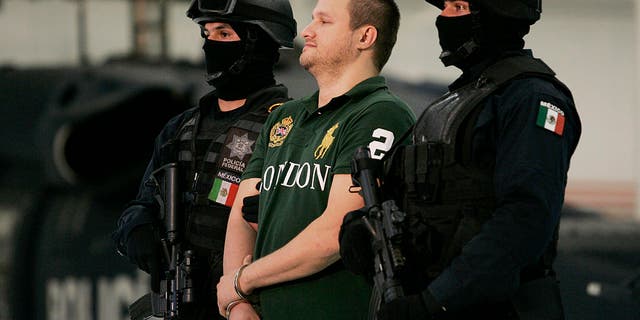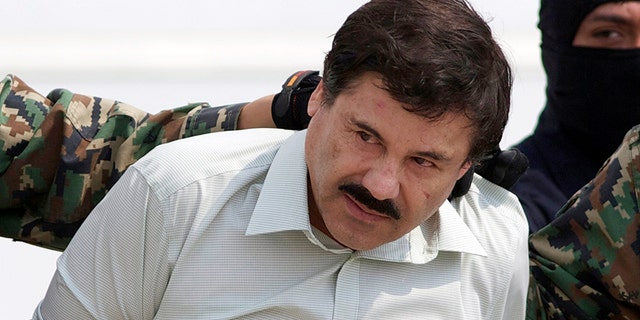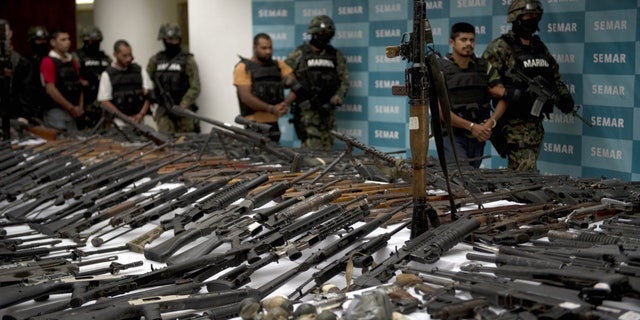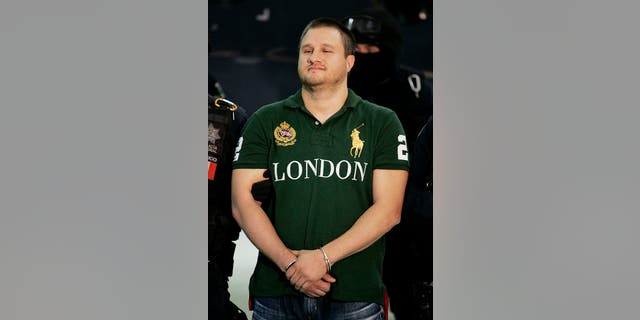Mexican authorities have expressed concern after a notorious cartel hitman seemingly disappeared from U.S. prison rolls without a trace.
The drug kingpin, known as “La Barbie,” was serving a nearly 50-year prison sentence in Florida for cocaine trafficking and is suspected of other horrific crimes, including orchestrating murders, beheadings and torture.
But just who is “La Barbie?”
Edgar Valdez Villarreal, 49, was born and raised in a middle-class suburb in Laredo, Texas. Family members who spoke to the New York Times in 2010 described his upbringing as fairly normal – his father was a local businessman and emphasized values of faith and hard work in their home. He played football at United High School, where he gained the nickname “La Barbie” because his fair complexion and blue eyes resembled a Ken doll.
NOTORIOUS CARTEL HIT MAN DISAPPEARS FROM US PRISON SYSTEM, LEAVING MEXICO DUMBFOUNDED
Edgar Valdez Villareal, “La Barbie,” center, of the Beltran Leyva drug cartel, is presented to the press at the Federal Police headquarters in Mexico City, on Aug. 31, 2010.
(ALFREDO ESTRELLA/AFP via Getty Images)
However, unlike his siblings who went to college and started businesses, Villarreal chose a life as an outlaw and would rise through the criminal underworld to become a lieutenant the now-defunct Beltrán-Leyva Cartel, treading over hundreds of corpses to get there.
Villarreal’s early encounters with law enforcement were for drunken driving and public drunkenness. His first arrest came at age 19 in Texas, where he was charged with criminally negligent homicide for allegedly running over a middle school counselor in his truck while speeding down a Laredo street. He was never indicted.
Villarreal began his drug trafficking career dealing marijuana in the 1990s, according to the Department of Justice. He eventually graduated to trafficking cocaine to customers in New Orleans and Memphis, Tennessee, shipping as much as 150-180 kilograms to distributors in other cities as well. Villarreal’s brother told the New York Times that in 1998, he fled to Nuevo Laredo, Mexico, to avoid arrest and never lived in the United States again. While there, he joined a local gang called Los Chachos and became involved in the city’s drug trade.
Through connections made in Mexico, Villarreal met Arturo Beltrán-Leyva, a leader of the namesake cartel, who was associated with the Sinaloa Cartel and Joaquin Guzman-Loera, a.k.a “El Chapo.” His fluency in English and Spanish, good looks and charismatic persona won him favor with drug lords, who gave him authority in their operations.
DOG CARRYING SEVERED HAND LEADS TO MORE THAN 50 BAGS OF HUMAN REMAINS FOUND IN MEXICAN STATE

Edgar “La Barbie” Valdez Villarreal is shown to the press during a news conference at the federal police center Aug. 31, 2010 in Mexico City. Valdez, a Texas-born drug smuggler and leader in the Beltran Leyva Cartel, was captured Aug. 30 by Mexican authorities in a residential area near Mexico City.
(Photo by Daniel Aguilar/Getty Images)
DOJ officials said Villarreal trafficked cocaine from Mexico, Columbia and other South American countries with backing from the cartel. He used speedboats and airplanes to transport the drugs and paid bribes to local law enforcement officials, Authorities in the U.S. and Mexico issued a warrant for Villarreal’s arrest in 2003 on charges of cocaine smuggling.
In public, Villarreal portrayed himself as a successful businessman. He wore expensive suits, drove nice cars and bought houses in Mexico City. Behind the scenes, he was a ruthless cartel hit man believed by some detectives to be responsible for the deaths of hundreds of people.

Joaquin “El Chapo” Guzman, the head of Mexico’s Sinaloa Cartel, being escorted to a helicopter in Mexico City following his capture in the beach resort town of Mazatlan Feb. 22, 2014.
(AP Photo/Eduardo Verdugo, File)
In the mid 2000s, “La Barbie” was directly involved in a vicious gang war against the Gulf Cartel and its then-partners the Zetas, a brutal and dangerous crime syndicate known for “shock and awe” tactics including beheadings, torture, and murder. By this time, Villarreal led Los Negros, an enforcement arm of the Sinoloa Cartel that used similar tactics against the Zetas.
Between 2005 and 2006, there were nearly 200 murders a year in Nuevo Laredo, as the Zetas and Los Negros turned the city into a battlefield. The cartel’s violent tactics mirrored those of radical Islamic terrorists in the Middle East. Villarreal allegedly taped videos of killings and was linked to one particularly gruesome video obtained by the Dallas Morning News in 2005. The video showed the interrogation of four members of the Zeta gang who were beaten and bloodied. Toward the end of the video, one of the men was shot in the head.
DOG SPOTTED IN MEXICO RUNNING WITH HUMAN HEAD IN ITS MOUTH

Mexican marines escort five alleged drug traffickers of the Zeta drug cartel in front of an RPG-7 rocket launcher, hand grenades, firearms, cocaine and military uniforms seized to alleged members of the Zetas drug traffickers cartel and presented to press on June 9, 2011, at the Navy Secretaryship in Mexico City.
(Yuri Cortez/AFP via Getty Images)
Authorities said at the time Villarreal may have been motivated to retaliate against the Zetas for killing his brother, Armando Valdez Villareal.
As the war waged, “La Barbie” continued to rise through the ranks of the Beltrán-Leyva Cartel. He oversaw gang operations in the Mexican states of Sinaloa, Tamaulipas, Nuevo León, Veracruz, Jalisco and Guerrero, according to the Dallas Morning News. He became one of the most-wanted drug lords in Mexico, and by 2009, had a $2.3 million bounty on his head. In June 2010, Villarreal was indicted in a U.S. court on charges related to trafficking thousands of kilograms of cocaine from Mexico into the United States between 2004 and 2006.
However, “La Barbie’s” rise through the cartel was interrupted by infighting after the 2009 death of Arturo Beltrán-Leyva, who was killed in a gunfight with Mexican marines in Cuernavaca. Villarreal battled for control of the cartel against Beltrán-Leyva’s brother, Hector, entering into a bloody years-long feud. Decapitated and dismembered bodies littered the streets of Cuernavaca and Acapulco – and were often hung from bridges – along with messages threatening one of the two feuding factions.
The violence forced Villarreal to give up his flashy lifestyle in Acapulco and retreat to Mexico City, where he kept a lower profile, according to Mexican authorities. Many of his key allies had been killed in the conflict, and disgruntled henchmen became informants for police who were working to apprehend the drug kingpin.
7 CARTEL MEMBERS, 1 MEDICAN SOLDIER KILLED IN SHOOTOUT NEAR US BORDER

Edgar Valdez-Villareal was extradited to the U.S. in 2015 and sentenced to 49 years in prison. He was being housed at a facility in Florida.
(Daniel Aguilar/Getty Images)
“La Barbie” was finally captured by Mexican authorities in 2010, following an effort by then-Mexican President Felipe Calderon to crack down on organized crime. He was extradited to the U.S. in 2015 to face charges. In January 2016, he pleaded guilty to charges of conspiring to import and distribute cocaine, and conspiring to launder money.
A judge in Atlanta sentenced Villarreal to 49 years and one month in federal prison in 2018, a sentence for which he was serving time when he disappeared from Bureau of Prisons (BOP) custody in November.
The BOP did not immediately respond to a request for comment from Fox News Digital, but a spokesman told the New York Post they do not comment on prisoner transfers.
CLICK HERE TO GET THE FOX NEWS APP
“We do not provide specific information on the status of inmates who are not in the custody of the BOP for safety, security or privacy reasons,” the spokesman told the outlet.
Villarreal’s whereabouts are currently unknown.
Fox News’ Anders Hagstrom and the Associated Press contributed to this report.